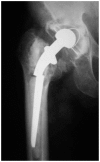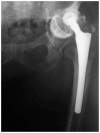Hip painful prosthesis: surgical view
- PMID: 22461809
- PMCID: PMC3279071
Hip painful prosthesis: surgical view
Abstract
Painful hip prosthesis is the most feared immediate and remote complication of a primary implant and usually represents the failure of one or more therapeutic moments. In cases of aseptic implant failure, the causes invoked may be represented by an incorrect indication, the quality of materials, local and general condition of the patient and especially from a bad joint biomechanics. In cases of septic loosening, however, the cause of failure to be found in the location of pathogens within the implant. In planning a revision is necessary to respect many important steps. They are represented by the exact identification of the causes of failure, the correct preoperative planning, by respecting the skin incisions, the proper choice of the prosthesis, planning the surgical technique, and finally by an appropriate rehabilitation program.In the evaluation of hip failure the first diagnostic step is to recognize exactly those aseptic and septic forms anyway to exclude the diagnosis of infection.
Keywords: THA; bone-loss; infection; loosening.
Figures
References
-
- Desal MA, Bancroft LW. Periprosthetic osteolysis. Orthopedics. 2008;31:518. - PubMed
-
- Harris WH. The problem is osteolysis. Clin Orthop Relat Res. 1995:46–53. - PubMed
-
- Harris WH. Osteolysis and particle disease in hip replacement. A review. Acta Orthop Scand. 1994;65(1):113–123. - PubMed
-
- Berquist TH. Imaging of joint replacement procedures. Radiol Clin North Am. 2006;44(3):419–437. - PubMed
- Howie DW, Neale SD, Stamenkov R, Mc-Gee MA, Taylor DJ, Findlay DM. Progression of acetabular periprosthetic osteolytic lesions measured with computed tomography. J Bone Joint Surg Am. 2007;89(8):1818–1825. - PubMed
LinkOut - more resources
Full Text Sources
Research Materials




